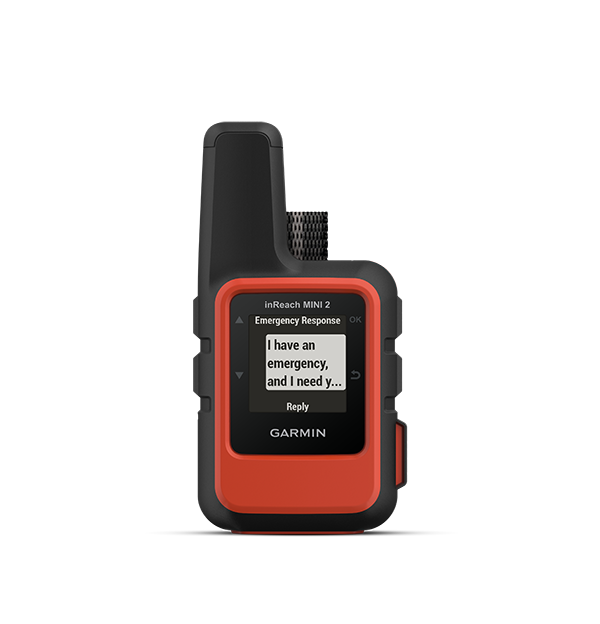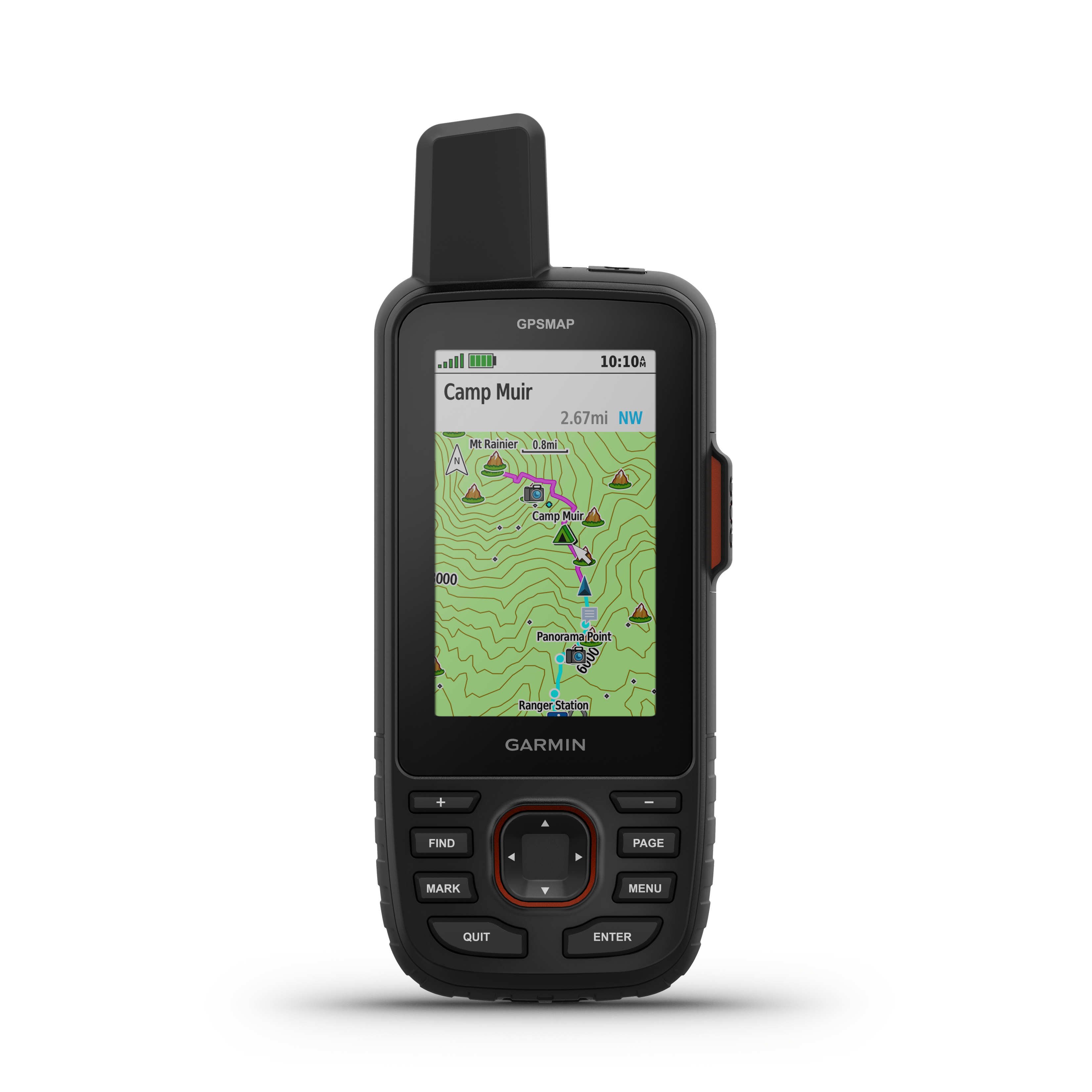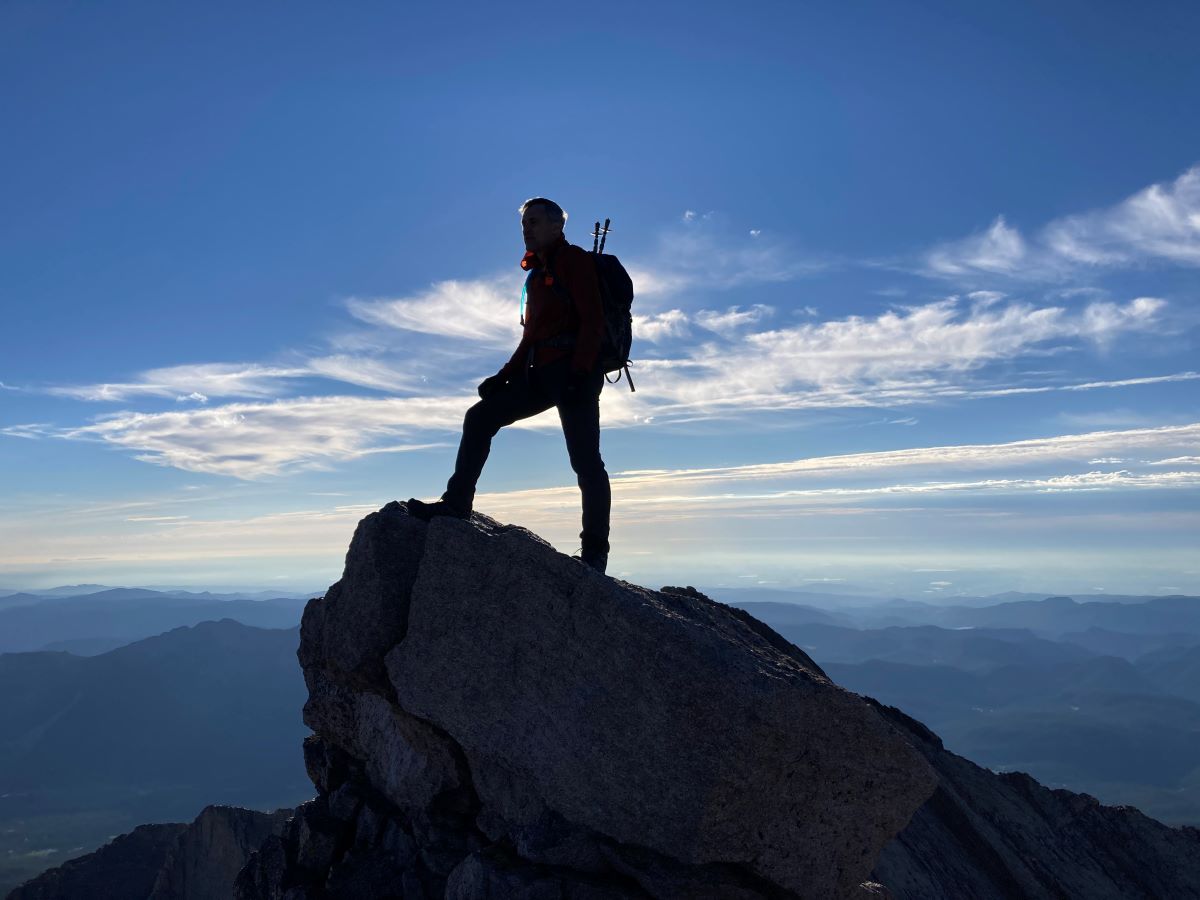
Story of Survival: Mountaineer Trapped on a Ledge for 6 Hours
Despite being prepared and experienced, Andreas Stabno found himself in a situation he never thought he would — trapped on a precarious mountain ledge with nothing to do but hang on and wait. He shared with Garmin what happened that day.
Andreas Stabno has run marathons, crossed the Grand Canyon and returned in one day, rappelled into and waded through Utah canyons, scaled Mount Kilimanjaro with his father and summitted 55 of Colorado’s highest peaks — among other adventures.
He’s a husband, a father, an active member of his community, and in his career has led risk management and guided complex teams.
“I’m the typical man who doesn’t ask for directions, doesn’t need help and takes care of himself,” he said.
So when Stabno was persuaded by his wife to buy an inReach® satellite communication device¹, he thought it was silly to pay money for something he thought he would never need.
But on one fateful summer day, he did.
“Without it, I would not be telling this story today,” he said.
1:00 a.m.
Stabno is prepared. Other than the clothes and boots he’s wearing, he has a spare pair of socks, gloves, a helmet, baseball cap, neck buff, sunglasses, sunscreen, lip balm, fuel and food, 3 liters of water, a map, compass, phone for navigation and a backup battery, a knife, matches, pencil and paper, first aid kit, reflective space blanket, driver’s license, toilet paper, hand sanitizer and a pair of hiking poles.
He thinks about every detail, including exactly how he double layers his socks to avoid any creases that may cause blisters. Checking his phone, he sees that the weather forecast is about to be updated, so opts to wait until 1:30 a.m. for one last confirmation that it still looks like a bluebird day for the hours he intends to be in the mountains. It does.
2:20 a.m.
It’s the middle of August and already 52°F. Ready for an epic day, Stabno hikes at an aggressive pace, heating up quickly under the light of the moon. He thinks about his love for this activity, this place. His objective for the day is traversing the ridgeline above Glacier Gorge, ending by summiting McHenrys Peak. It’s one of his favorite areas in Rocky Mountain National Park.
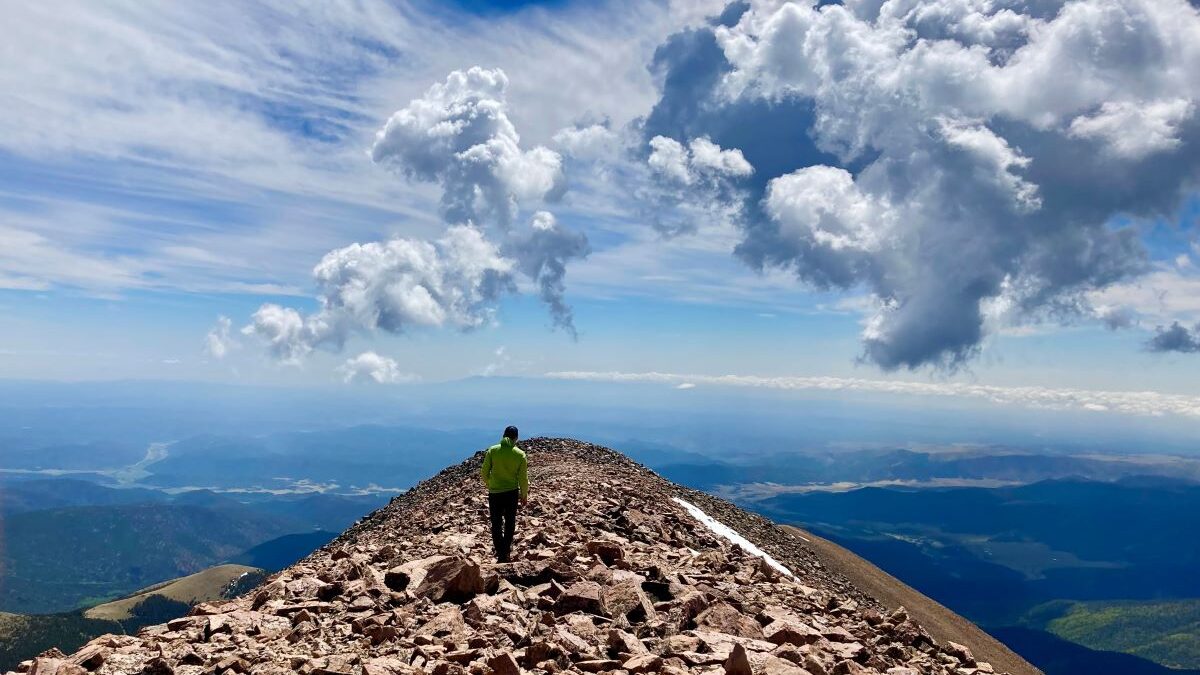
10:00 a.m.
Stabno has already hit five summits: Flattop, Hallet, Otis, Taylor (13,100’ elevation) and Powell. The sky is clear, the wind is calm, and he only has one more peak on his route before the return through Glacier Gorge to the car. He puts on his helmet to prepare for a very loose gully descent and then a technical, rocky ascent.
He studies the near-vertical wall below McHenrys’ notch and spots a line weaving through the terrain that he deems — from his research and observations — to be acceptable. The rock looks solid, and the climb is supposed to be within his ability level.
But once he’s about 100’ up he starts to get uncomfortable. All options appear harder than he expected, but a bypass to the right seems feasible. He takes it.
11:00 a.m.
Stabno arrives at a small ledge. Unable to advance through the wide cracks safely in either direction from there, he tries to find places to put his hands and pull himself up, but has nowhere to put his feet. Any movement would require advanced climbing technique and gear. Quickly Stabno realizes he’s 100-150’ above ground with nowhere to go without serious risk.
11:10 a.m., 10 Minutes on the Ledge
“In that moment, I knew that moving would get me in serious trouble and help would take time to arrive because I am in one of the most remote areas of the park — about 8 miles from any road and trailhead,” he said. “So, I don’t hesitate.”
Stabno grasps his inReach device and pushes the SOS button.
He also uses the two-way texting on his device to message his wife and explain the situation, leaving out some of the more harrowing details.
And now all he can do is wait — on a ledge that he describes as having about 3’ of usable space in length, being only 8” wide, sloping downward to one side, and only reasonably secure when grasping an under-cling pinch in the wall with his left hand and a small, rounded rock feature with his right. One of his heels is slightly hanging over the ledge.
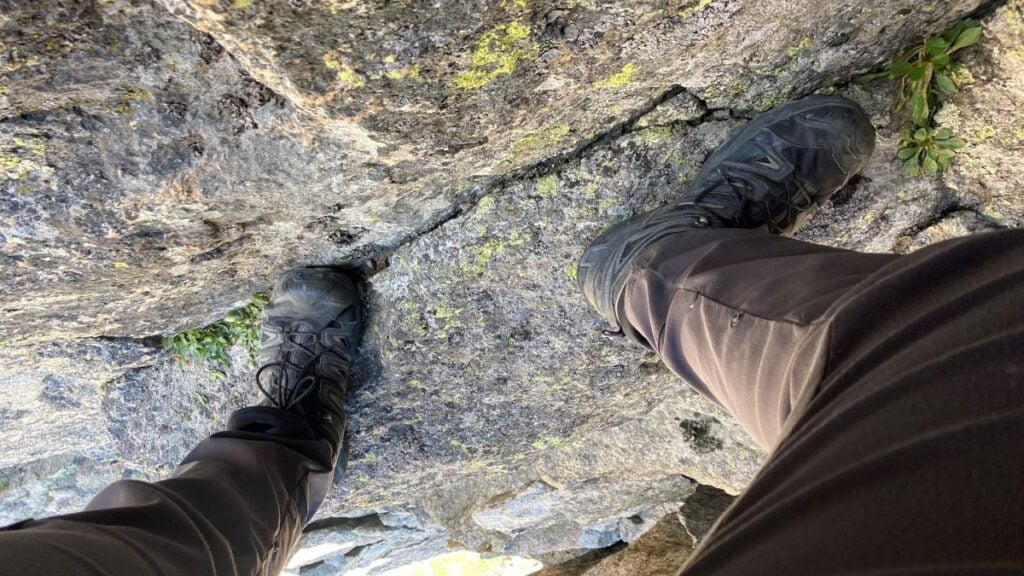
1:00 p.m., 2 Hours on the Ledge
Responders determine that Stabno’s location will be a difficult, technical rescue. While waiting, he’s received more information about the rescue response. Help is on the way, but it will likely take hours to safely get to his location.
Stabno’s fear mounts.
“By carefully taking off my backpack and pressing it between me and the wall, I manage to remove my battery backup and place it in one pants pocket while connecting it to my phone in the other pocket,” he said. “I am already wearing a windbreaker over my shirt, but I know I can get cold fast because I am no longer moving, so I extract my space blanket from my emergency kit, unfold it and wrap it around my torso under my shirt. This is challenging as I am holding on to the rock with one hand at a time.”
Then, he has nothing left to do but stand and wait, drink water and shift the weight on his feet every so often.
1:30 p.m., 2.5 Hours on the Ledge
Stabno is tired and cold and begins to break down mentally and emotionally. His kids are sending him messages, pleading with him to hold on.
2:00 p.m., 3 Hours on the Ledge
He sees dark clouds forming in the distance and hears a subtle rumble of thunder. Spots of rain dribble down his jacket, quickly turning into hail that bounces off his helmet. Before long, his clothes are soaked, and the ledge is slick with moisture.
4:00 p.m., 5 Hours on the Ledge
Stabno is cold and shaking uncontrollably. He informs the responding rangers that he’s growing desperate. They assure him a helicopter is on the way and a search and rescue (SAR) team is still making their way in.
“I am lonely with too much time in my head, and I can only focus on the pressing tasks of the present,” Stabno said. “But every few minutes I am interrupted with a message of support or a check-in from the park service or my family and friends.”
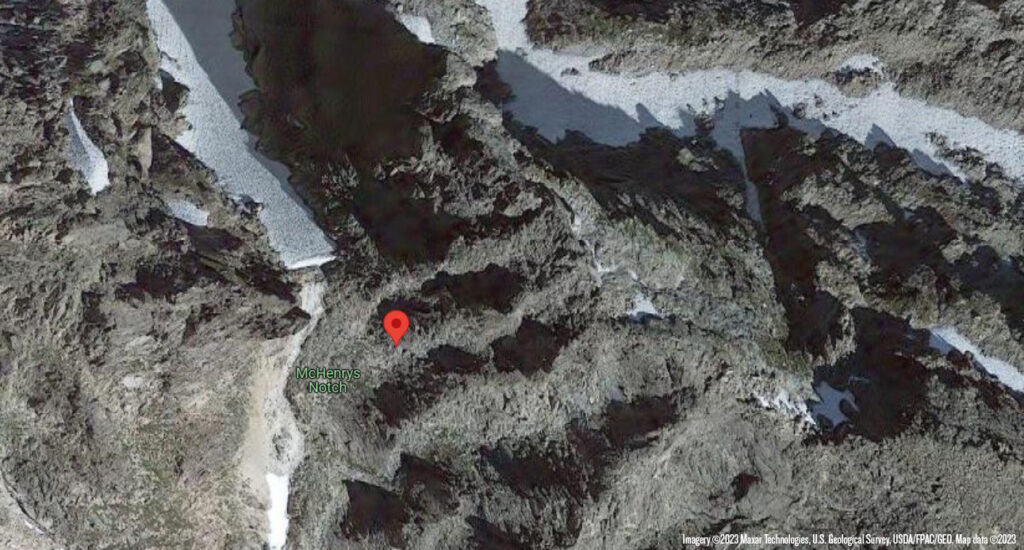
4:30 p.m., 5.5 Hours on the Ledge
Stabno hears what he describes as, at the time, a beautiful sound: the dim noise of helicopter rotors spinning in the distance. As it approaches, the sound becomes a deafening roar, but then it trails away and quiet takes over.
When it returns, Stabno waves his arm as much as he can while still clinging to the wall.
It makes several passes, unable to find a safe position for both Stabno and the rescuers, and it eventually flies away again.
5:00 p.m., 6 Hours on the Ledge
Out of nowhere, Stabno hears a voice from above calling his name and confirming his location. Rescuers dropped off by helicopter near the summit are preparing to reach Stabno. The voice says they’ll be down to him in 10 minutes.
5:30 p.m., 6.5 Hours on the Ledge
The rescuer rappels down and puts a harness on Stabno, securing him into the rope system. They use jumars to climb pitch-by-pitch up the rock wall.
6:10 p.m., Off the Ledge
Stabno finally has made it to level terrain, and the rescue team informs him the helicopter will be coming back to take them up. He’s put into a new harness, clipped into the carabiner of the hoist and shortly is flying up through the air and into the safety of the National Guard helicopter.
“Because of the noise, I cannot communicate other than through the gratitude of my flowing tears, and I gain a renewed appreciation for the professionalism and sacrifice of those who give their lives in service to others,” Stabno said.
A few minutes later, they land near park headquarters, and Stabno exits the cabin. At the office, he’s medically assessed and debriefed by rangers about the day, especially regarding how he prepared and the decisions he made that led to getting stuck.
And finally, Stabno hears the sound he’s been waiting for. His family has arrived.
After the Rescue
Today, Stabno said that he is feeling “alive and deeply grateful.”
“The heroes are the two mountaineers from Rocky Mountain Rescue, the helicopter team from the National Guard and the entire National Park Service command center,” he said. “With military precision and a measured calm, their actions saved my life.”
He said his rescue was only executed in time because he was able to send the inReach SOS immediately.
“I am uncertain how much longer I would have been able to hang on or how the weather conditions would have changed had my rescuers arrived even just a half hour later,” he said.
Stabno also recognized the heroics of his wife back at home, who communicated with emergency services, organized their community and checked on him constantly throughout the day. He said the messages and good energy he was able to receive from his community were what gave him the strength to hold on just long enough.
And while the main feeling following the ordeal was gratefulness, Stabno did have a few other simple takeaways:
“Know your ability,” he said. “Do your research. Stay humble. Be prepared to turn back. Have a reason to come back home.”
¹Active satellite subscription required. Some jurisdictions regulate or prohibit the use of satellite communication devices. It’s the responsibility of the user to know and follow all applicable laws in the jurisdictions where the device is intended to be used.
